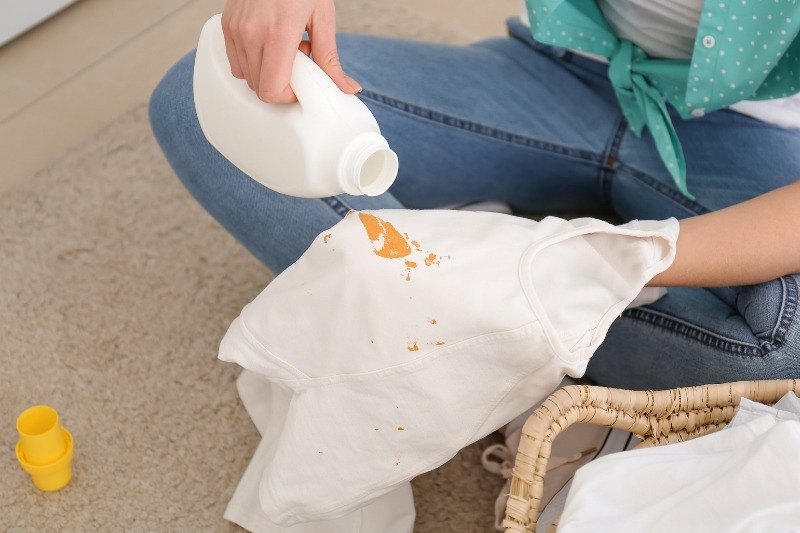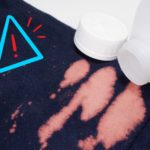White clothing looks bright and fresh, and you can pair a white t-shirt with almost any other item from your wardrobe!
However, white is also the easiest colour to stain. From coffee to grass stains, all types of dirt are visible on the colour white.
Whites also fade quickly, with your clothes turning duller and greyer with every washing cycle.
If your white clothes are looking stained and faded, fear not! We’re here to help you transform your clothes and give them an instant refresh using bleach.
Here’s a step-by-step guide on how to bleach white clothes, without ruining your garments or causing harm to yourself!
Health & Safety Considerations Before Bleaching Clothes
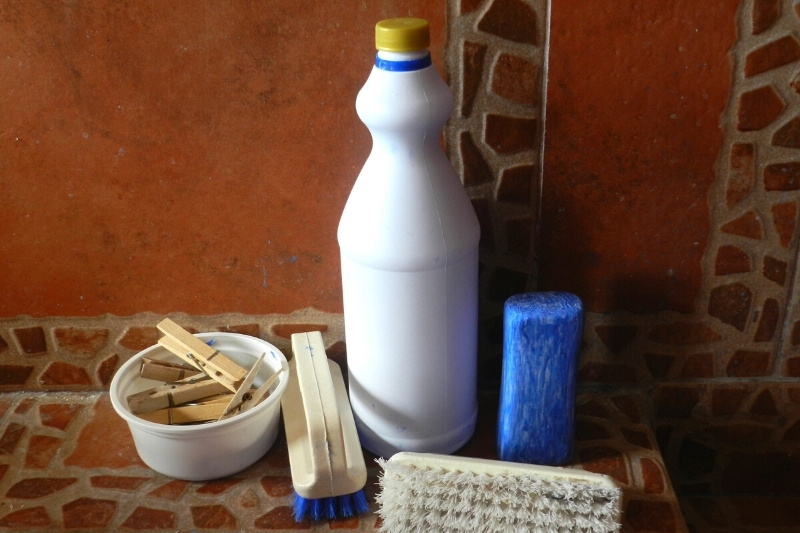
Bleach is an effective method for refreshing white clothes and returning their initial brightness. However, it is also a strong chemical, and improper use can pose a risk to human health. Here are some things to consider so that you can bleach your clothes safely:
- Ensure good ventilation: Ensure the room in which you will bleach your clothes is well-ventilated. When using bleach indoors, adequate ventilation is necessary to avoid bleach toxicity which can cause respiratory, gastrointestinal, and ocular symptoms.
- Wear protective clothing: Avoid skin contact with the bleach by wearing rubber gloves and an apron for protection. Bleach is a corrosive chemical and can burn through your skin just as readily as it burns through stains! Always handle with caution to avoid hurting yourself.
- Avoid mixing with cleaning products: Never mix bleach with ammonia, acids, or other cleaning products. Doing so results in the production of toxic gases which are harmful to human health. Thankfully, most standard laundry detergents don’t contain these substances but double-check before using them in combination with bleach.
How to Bleach White Clothes Without Damaging Them
Not only can bleach damage your body, but it can also damage your clothes.
Therefore, you need to ensure that your clothes are safe for bleaching before going ahead. Otherwise, your whites might be in worse condition than when you started!
Below are some prerequisites to bleaching that help minimise the risks:
- Check the Label: Always check the label of your garments before using bleach. If the label says “no bleach,” put that bottle down! Even fabric-safe bleaches aren’t suitable for these clothes as the fabric is too delicate and could corrode.
- Perform a Spot Test: Even if your clothes don’t say “no bleach”, always conduct a patch test on your garments before bleaching to double-check that the material can handle the harsh chemicals. We suggest doing this in a hidden location, such as inside the collar.
- Choose the Right Bleach: You have two options for bleach when whitening clothes: chlorine bleach and oxygen bleach. Chlorine bleach is better at removing stubborn stains but should only be used on hard-wearing fabrics. Oxygen bleach is more gentle and is suitable for almost all clothes. Make sure you choose the right type of bleach for the clothing at hand.
How to Bleach White Clothes
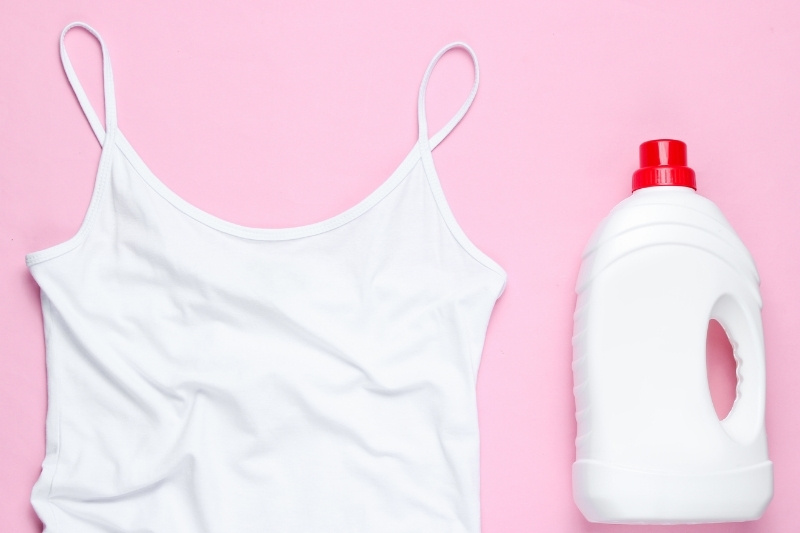
Now that you know the safety considerations and rules for avoiding damage, it is time to get to work! You can use two methods for bleaching clothes: soaking or washing in the machine.
Soaking clothes in bleach
One of the best ways to whiten white clothes with bleach is by soaking them in diluted bleach.
You will need bleach, a bucket or large container, and some cold water for this method.
Once you have everything ready, follow the below steps:
- Soak your clothes – Take your bucket or container (ensure it is large and durable enough) and fill it with cold water. Put your white clothes in the water and agitate the water to ensure all your clothes are completely wet through.
- Add bleach – Pour bleach into the container with the water and your whites. You should always check the dilution recommendations on the bottle, as this can vary between brands. However, a 1:99 ratio of bleach to water is a good guideline to follow.
- Wait for 10 minutes – Stir the contents of the container to ensure all your white clothes are bleached evenly. Set a timer for ten minutes, stirring intermittently while you wait. This should be enough time for your whites to soak and regain their brightness. Tip: Never soak your clothes for longer, or the bleach will weaken the fabric.
- Rinse in water – Remove the clothes from the container and rinse thoroughly under cold water. You must ensure you get all the bleach out of the fabric to avoid damage. Squeeze the material to remove the excess water, and then hang your whites out to dry.
Bleaching white clothes in the washing machine

Rather than soaking your dull whites in a bucket, you can bleach them in your washing machine. Make sure to only bleach clothes that can be safely washed by using this method, or you could cause further damage or shrinking! If you’re sure your clothes are appropriate, follow the steps below:
- Treat stubborn stains – If your whites have stubborn stains, apply detergent directly to the stain using a toothbrush and scrub a little. This will help the stain shift in the washing machine. You can skip this step if you’re just looking to brighten dull whites.
- Get the washing machine ready – Put your whites in the washing machine. If you’re using powdered bleach, add this to the drum with your clothes and shut the door. If using liquid bleach, pour the recommended amount into your washing machine’s bleach dispenser. You also need to place detergent in the washing machine as usual.
- Run a hot cycle – Set the temperature of your washing machine to hot (check the temperature recommendations on your clothes labels first) and run a short cycle. This allows the bleach, detergent, and clothes to mix so that the bleach can work its magic!
- Rinse & dry clothes – When the cycle has ended, remove the clothes and rinse in cold water to remove the excess bleach and avoid damage. Squeeze out the excess water and hand your clean, bright whites out to dry.
Bleaching White Clothes: Dos and Don’ts
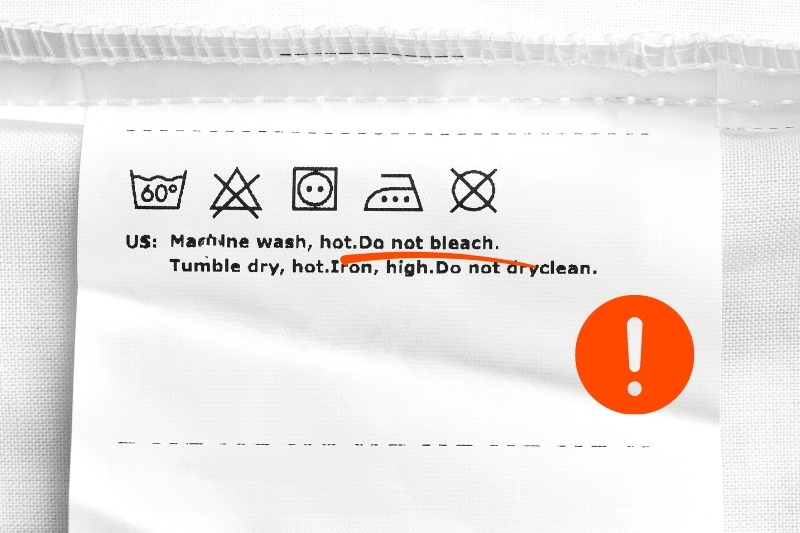
Bleach is a fantastic way to freshen up dull whites and remove stubborn stains, but the bleaching process must be done correctly!
Below is a recap of all the dos and don’ts so that you can be confident about how to bleach your clothes:
- DO wear gloves and a safety apron when handling bleach
- DO use the correct type of bleach (oxygen or chlorine) for the type of clothes you have
- DO always perform a spot test on a hidden piece of fabric
- DO check the instructions for the bleach you have and follow the dilutions accordingly
- DO clean up any spills immediately to avoid damage to your floors and furniture
- DON’T bleach clothes that say “no bleach” or wash clothes that say “handwash only”
- DON’T leave your whites to soak for longer than 10 minutes
- DON’T pour bleach directly onto your whites, or this will cause damage
- DON’T assume all clothes can be washed on hot – always check the label
- DON’T over-bleach as this can cause your whites to turn yellow

Hannah has a passion for cleaning. She worked her way around Australia by cleaning hostels in exchange for free accommodation and used her cleaning skills to bag a job as a chalet host for a luxury ski company in France.
